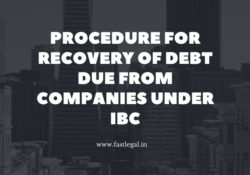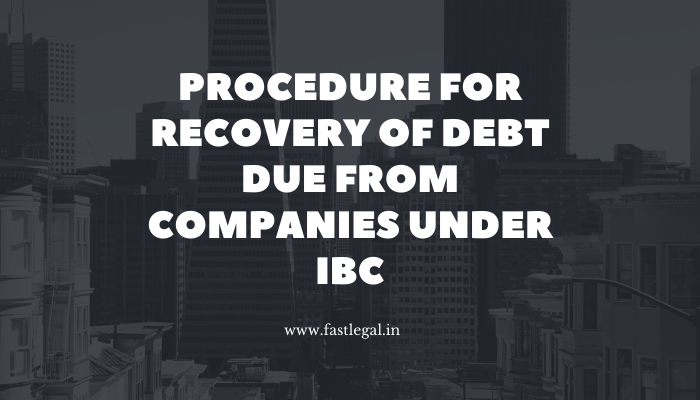Insolvency and Bankruptcy Code provides Voluntary Liquidation of Corporate Persons in India, A corporate person who intends to liquidate itself voluntarily and has not committed any default may initiate voluntary liquidation proceedings under Chapter V of Insolvency and Bankruptcy Code (IBC) , Section 59 of IBC provides for Voluntary Liquidation of Corporate Persons.
Procedure for Voluntary Liquidation of Company Under IBC
Voluntary liquidation proceedings of a corporate person registered as a company shall meet the following conditions:
- A declaration from majority of the directors of the company verified by an affidavit stating that –
- (i) they have made a full inquiry into the affairs of the company and they have formed an opinion that either the company has no debt or that it will be able to pay its debts in full from the proceeds of assets to be sold in the voluntary liquidation; and
- the company is not being liquidated to defraud any person
- Above Declaration shall be accompanied by :
- Audited financial statements and record of business operations of the company for the previous two years or for the period since its incorporation, whichever is later
- a report of the valuation of the assets of the company, if any prepared by a registered valuer
- Within Four Weeks of Above Declaration there shall be a special resolution of the members of the company in a general meeting requiring the company to be liquidated voluntarily and appointing an insolvency professional to act as the liquidator, or
- A resolution of the members of the company in a general meeting requiring the company to be liquidated voluntarily as a result of expiry of the period of its duration, if any, fixed by its articles or on the occurrence of any event in respect of which the articles provide that the company shall be dissolved, as the case may be and appointing an insolvency professional to act as the liquidator
- Where Company Owes any Debt to any Person :
- creditors representing two thirds in value of the debt of the company shall approve the resolution passed under sub clause (c) within seven days of such resolution (Special or Ordinary Resolution as mentioned above)
Reporting to Registrar of companies and Board about Voluntary Liquidation Process by Company:
- within seven days of such resolution or the subsequent approval by the creditors, as the case may be
The voluntary liquidation proceedings in respect of a company shall be deemed to have commenced from the date of passing of the above resolution subject to the approval of Creditors of Company
- Once the Above is complete,
- The liquidator shall receive or collect the claims of creditors within a period of thirty days from the date of the commencement of the liquidation process
- The Financial and Operational Creditor will submit the claims.
- A creditor may withdraw or vary his claim under this section within fourteen days of its submission
- The liquidator will verify the claims submitted
- The liquidator may, after verification of claims, either admit or reject the claim
- The liquidator will communicate his decision of admission or rejection of claims to the creditor and corporate debtor within seven days of such admission or rejection of claims
- The liquidator will determine the value of claims admitted
Distribution of assets in case of Liquidation of Company:
- The proceeds from the sale of the liquidation assets shall be distributed in the following order of priority : –
- The insolvency resolution process costs and the liquidation costs paid in full;
- The following debts which shall rank equally between and among the following:
- workmen’s dues for the period of twenty-four months preceding the liquidation commencement date; and
- debts owed to a secured creditor in the event such secured creditor has relinquished security
- wages and any unpaid dues owed to employees other than workmen for the period of twelve months preceding the liquidation commencement date;
- financial debts owed to unsecured creditors;
- the following dues shall rank equally between and among the following: –
- any amount due to the Central Government and the State Government including the amount to be received on account of the Consolidated Fund of India and the Consolidated Fund of a State, if any, in respect of the whole or any part of the period of two years preceding the liquidation commencement date;
- debts owed to a secured creditor for any amount unpaid following the enforcement of security interest
- any remaining debts and dues;
- preference shareholders, if any; and
- equity shareholders or partners, as the case may be
Where the affairs of the corporate person have been completely wound up, and its assets completely liquidated, the liquidator shall make an application to the Adjudicating Authority (NCLT) for the dissolution of such corporate person
The Adjudicating Authority shall on an application filed by the liquidator pass an order that the corporate debtor shall be dissolved from the date of that order and the corporate debtor shall be dissolved accordingly
A copy of an order of dissolution shall within fourteen days from the date of such order, be forwarded to the authority with which the corporate person is registered (ROC) .
Need Voluntary Liquidation Services for your Company – Please Email us at Support@fastlegal.in or call at 9782280098


